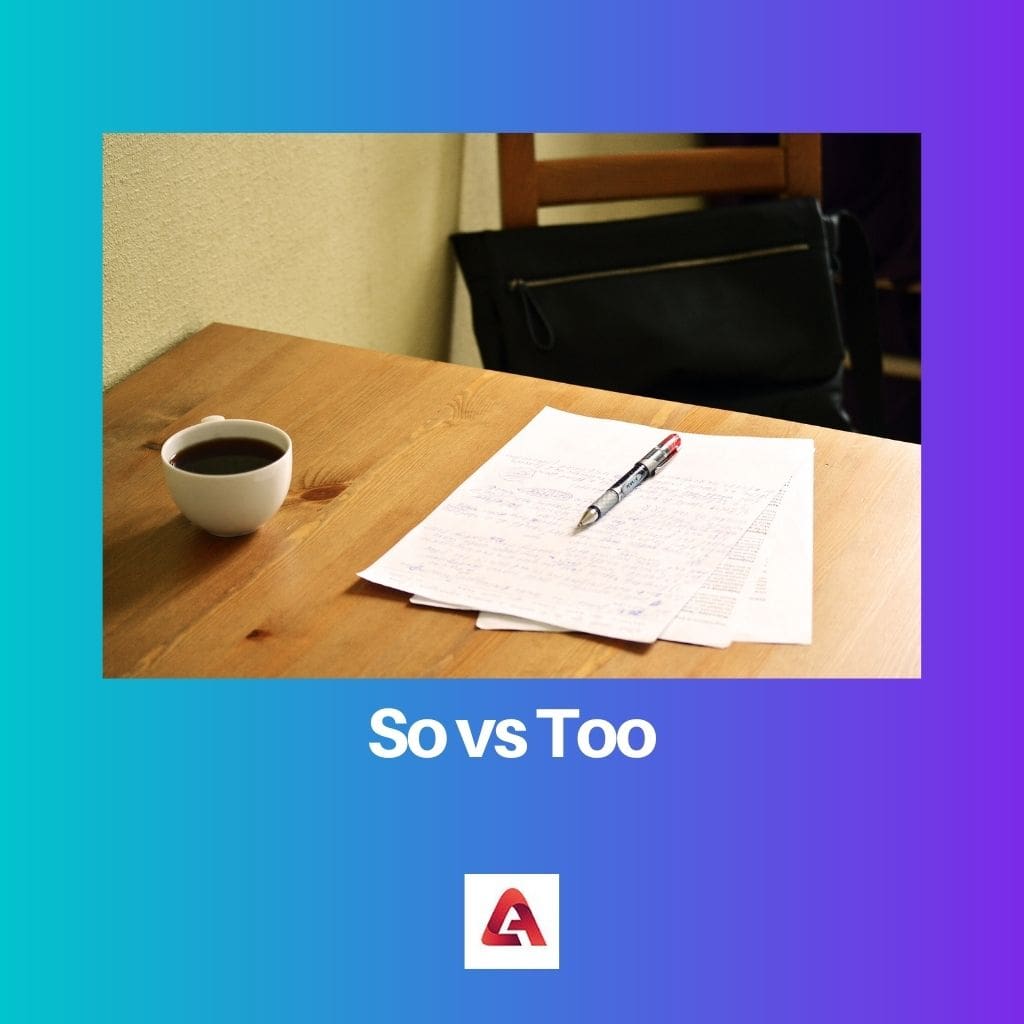‘SO’ and ‘Too’ are two separate terms used in English to refer to a significant quantity.
Key Takeaways
- “So” is an adverb used to emphasize a degree or extent, while “too” is an adverb that means “excessively” or “also.”
- “So” can describe a result or consequence, whereas “too” indicates an undesirable or excessive amount.
- “So” can introduce a clause explaining the reason for an action, while “too” only modifies an adjective or adverb.
So vs Too
The difference between So and Too is that the former refers to a quantity of a ‘great degree’ but within the possible or prescribed limit. At the same time, the latter refers to an amount more significant or higher than the prescribed or possible limit.

In English, the word ‘So’ is mainly used as an adverb, a conjunction or an adjective of quantity. As an adjective of abundance, it implies a ‘degree that is great,’ e.g. She is so intelligent.
‘Too’, on the other hand, is used as an adverb or an adjective of quantity. As an adjective of abundance, it implies a degree higher than possible or permissible, e.g. He overeats.
Comparison Table
| Parameter of Comparison | So | Too |
|---|---|---|
| Usage in Grammar | As an adverb, a conjunction or an adjective of quantity. | An adverb or an adjective of quantity. |
| As an adjective of quantity | It means ‘of great degree’ or ‘of the same level’ when compared. | It means ‘of higher degree than possible or permissible’. |
| Other meanings | 1. Therefore, hence. 2. so that, With the aim or intention of. | Also or in addition |
| Homophones | Sow | To and Two |
| Alternative Words | Very, Remarkably | Excessive, Overly |
When to Use So?
In a sentence, ‘So’ may be used as a conjunction, adverb or adjective of quantity. The word is Germanic and related to ‘Zo’ in Dutch.
As an adjective of quantity, it can be used in two ways:
- To indicate something of great extent (used to give emphasis). For example:
- She is so good at studies.
- He is so athletic.
- To imply something of the same degree (applied in comparisons). For example:
- She is not as innocent as you think her to be.
- He is not so good as you believe him to be.
As a Conjunction, it is used in a variety of ways:
- To justify a reason or to introduce a consequence. For Example:
- I was feeling tired, so I went to sleep.
- I was not talking to her, so she went home.
- With the intention or aim of. e.g., He always eats healthy so that he does not fall sick.
- To launch a question. E.g. So, What next?
- To begin a concluding statement. E.g. so, that is that.
It can also be used as an adverb to imply something already mentioned. For example:
- Similarly, e.g. she has changed a lot, and so have I.
- To show concurrence with a feeling or an opinion (used with an exclamatory mark), e.g. X: I have learnt how to sing. Y:
While using ‘So’ in a sentence, two things must be kept in mind:
- ‘So’ cannot be used before an adjective+ attributive adjective. In its place, ‘Such’ should be used. For example, She sent me such lovely gifts for my birthday. And not She sent me so beautiful gifts for my birthday.
- ‘ Such’ should be used to modify noun phrases and not ‘So.’

When to Use Too?
In sentence construction, ‘Too’ can be used as an adverb or an adjective of quantity. The term is of English origin and is the stressed version of the word ‘To’.
As an adjective of quantity, it implies a degree higher than the permissible or possible limit. In other words, it indicates an amount that is ‘more than enough’.
- At the end of a sentence, to imply something that is in addition. For example:
- I love sweets too.
- She would love to come too.
- To indicate something specific. Mainly used to stress a positive answer to a negative statement, e.g. I am not going to the party. You are too!
While using ‘Too’ in a sentence, it is essential to remember that although it can be used before an adjective or an adverb, e.g.
It should be. He is very handsome. (Here, ‘very’ should be used to stress ‘handsome’.)

Main Differences Between So and Too
- In sentence construction, both ‘So’ and ‘Too’ are used as adverbs or adjectives of quantity. But ‘So’ is also used in conjunction, but ‘Too’ is not.
- The main difference between ‘So’ and ‘Too’ is that as adjectives of quantity, the former refers to a great degree but not higher than the permissible or possible limit.

- https://dictionary.cambridge.org/grammar/british-grammar/too
- https://dictionary.cambridge.org/grammar/british-grammar/so

The comparison table is very effective in highlighting the differences between ‘So’ and ‘Too’.
Absolutely, it simplifies the comparison.
I agree, it’s a great visual aid.
I find the information in this article to be very useful. It cleared up some questions I had about the use of ‘So’ and ‘Too’.
It’s a great resource for anyone looking to improve their grammar.
This article is a valuable resource for anyone learning English grammar.
Yes, it’s an excellent reference.
I found this article to be insightful and well-written. It really helps clarify the usage of ‘So’ and ‘Too’.
Absolutely, it’s a great learning tool.
The comprehensive explanation of the use of ‘So’ and ‘Too’ is commendable.
It’s definitely a thorough guide.
I had a good laugh reading this, it’s a witty take on ‘So’ and ‘Too’.
Definitely a refreshing approach to explaining grammar.
Yes, it’s informative and entertaining.
I think this article provides a clear explanation of the differences between ‘So’ and ‘Too’ and how to use them properly.
It definitely helps to avoid common errors with these words.
Yes, and the comparison table is very helpful.
The references provided at the end are a nice touch. It gives credibility to the content.
I completely agree.
I appreciate the detailed explanation of when to use ‘So’ and ‘Too’. It has cleared up some common misconceptions for me.
Definitely a helpful guide.
I wish I had found this sooner.
This article is truly illustrative. It makes it very easy to understand the usage of ‘So’ and ‘Too’.
I’m glad to hear that.